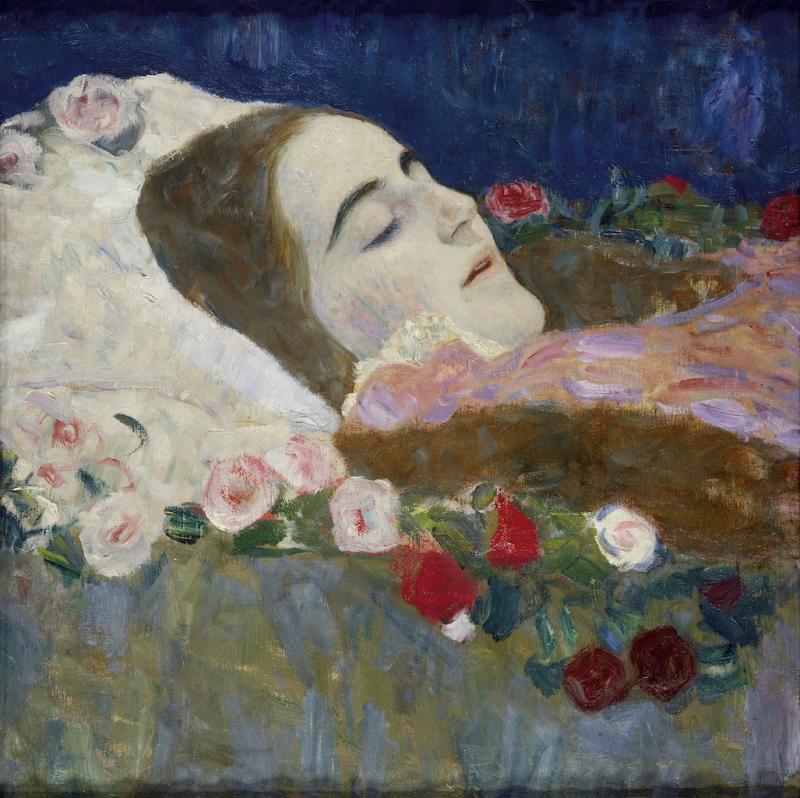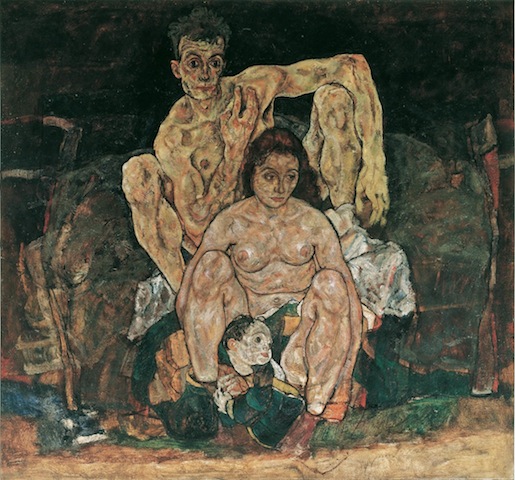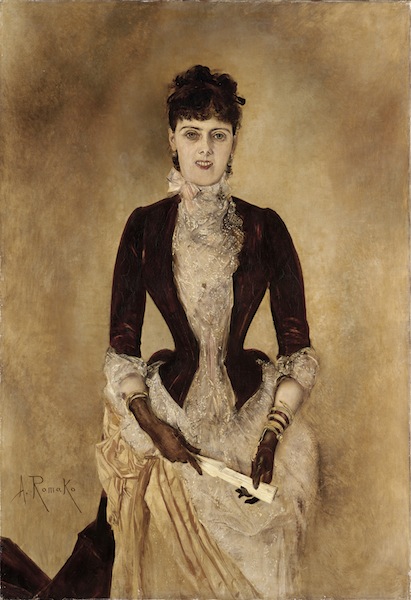Facing the Modern: The Portrait in Vienna 1900, National Gallery | reviews, news & interviews
Facing the Modern: The Portrait in Vienna 1900, National Gallery
Facing the Modern: The Portrait in Vienna 1900, National Gallery
A rich, complex portrait of Viennese society before the Great War

“We should pity the age which finds its reflection in this ‘art’”, wrote one critic in 1911, after seeing too many Vienna Secession paintings. From the quotation marks, we see the despairing critic was attacking the art rather than the age.
Its bared row of tombstone teeth exactly resembles the killer-trap mouth of a de Kooning woman
It is a certain pity, as well as fascination, that is excited by the National Gallery’s Facing the Modern: The Portrait in Vienna 1900, which, in fact, embraces a much longer time-frame – from portraits of the 1830s to 1918. It seeks to explore how the reins of tradition and convention were strained, then snapped, and how a certain wildness of emotion ran amok. Pain, awkwardness, anxiety, postures at odds with the polite surface of things – these were the tropes of the new modernist aesthetic. The Romantic sensibility is at work here, but also something that looks and feels much more real, raw, hunted and haunted.
The exhibition is as much a portrait of Vienna in the years leading up to the First World War, than it is an exploration of the portraits of Schiele, Kokoschka, Klimt and all the now lesser-known artists working at that time in a city full of newly arrived Jewish émigrés eager to establish themselves and assimilate in an ostensibly cosmopolitan society virulently hostile to them. Death and sickness stalk the exhibition. It begins with a death mask, that of Beethoven, who died in 1827, and ends with the death masks of Schiele, Klimt, Mahler and Loos. In between there are portraits of subjects painted in death as well as portraits of subjects painted in life but who were dead by the time the work was commissioned. Suicide among the young, young Jewish men in particular, had reached epidemic levels.
Klimt paints a young woman, beautiful in death, surrounded by flowers (main picture). She had shot herself in the heart over a failed love affair. He was commissioned to paint her again as if in life, from a photograph. She turns to us, gaily, smiling, as she again emerges from a decorative motif of flowers. But the painting remains unfinished – we are, by now, in the middle of war and Klimt is in the last year of his own life. Here, the dress, just sketched in, untouched by paint, resembles a shroud.
 There’s an achingly tender portrait by Klimt of his dead baby son, one of Emperor Franz Joseph on his deathbed by the now little-known Von Matsch (painted in the early 1830s, when the dynasty was in a more robust state, a dour portrait of the emperor's father, Archduke Franz Karl opens the exhibition), and a drawing by Schiele of his pregnant wife, hours from death. Schiele too was to succumb to Spanish flu just three days later. It’s his last portrait. Then there’s Richard Gerstl, the young artist who taught the composer Schoenberg to paint. Two of the composer’s portraits are on display – crude paintings using bright expressive colours. Schoenberg believed that what made his portraits so compelling – they aren’t particularly – was the fact that, as an untrained artist, he relied only on raw intuition.
There’s an achingly tender portrait by Klimt of his dead baby son, one of Emperor Franz Joseph on his deathbed by the now little-known Von Matsch (painted in the early 1830s, when the dynasty was in a more robust state, a dour portrait of the emperor's father, Archduke Franz Karl opens the exhibition), and a drawing by Schiele of his pregnant wife, hours from death. Schiele too was to succumb to Spanish flu just three days later. It’s his last portrait. Then there’s Richard Gerstl, the young artist who taught the composer Schoenberg to paint. Two of the composer’s portraits are on display – crude paintings using bright expressive colours. Schoenberg believed that what made his portraits so compelling – they aren’t particularly – was the fact that, as an untrained artist, he relied only on raw intuition.
By contrast, the subjects in Gerstl’s own paintings, himself included, look as if they’re disintegrating, psychologically and physically. The artist, who died by his own hand aged 25 after Schoenberg’s wife returned to her husband after their brief affair, presents his skeletally naked frame against a rough whirl of scored paint marks. It’s a dark, haunting painting. But far more disturbing is the self-portrait you’ll find on the other side of the canvas of his portrait of composer Alexander Zemlinsky, painted shortly before Gerstl committed suicide in 1908. The painting backs onto glass fitted into a temporary wall and when you go round to the other side you are greeted by his upside-down grinning head. It’s a wretchedly disturbing image. (The exhibition, incidentally, is laid out to suggest rooms and hallways, making the space feel deliberately claustrophobic.)
 We have Schiele’s large painting, The Family (Self-Portrait, 1918 (pictured above right; © Belvedere, Vienna), in which he poses with his wife (actually a model) and child, an agonised subversion of the ideal of the Christian family. But the portrait I find most startling is one by Anton Romarko, Portrait of Isabella Reisser, 1885 (pictured left; © Leopold Museum Private Foundation, Vienna). Isabella is richly dressed, as one would expect in a society portrait (he got the commission only after favoured Viennese society portraitist Hans Makart died), but one must wonder at her reaction on first seeing it. There is something awful, almost insect-like about her features and her yellowing flesh resembles that of flesh sunken in death. What's more, her red mouth, with its bared row of tombstone teeth, exactly resembles the killer-trap mouth of a de Kooning woman.
We have Schiele’s large painting, The Family (Self-Portrait, 1918 (pictured above right; © Belvedere, Vienna), in which he poses with his wife (actually a model) and child, an agonised subversion of the ideal of the Christian family. But the portrait I find most startling is one by Anton Romarko, Portrait of Isabella Reisser, 1885 (pictured left; © Leopold Museum Private Foundation, Vienna). Isabella is richly dressed, as one would expect in a society portrait (he got the commission only after favoured Viennese society portraitist Hans Makart died), but one must wonder at her reaction on first seeing it. There is something awful, almost insect-like about her features and her yellowing flesh resembles that of flesh sunken in death. What's more, her red mouth, with its bared row of tombstone teeth, exactly resembles the killer-trap mouth of a de Kooning woman.
There are lots of what one might readily call conventional portraits, too. Makart’s portraits of women make them look both sexy and regal, or more like the portraits of the comely buxom courtesans of an emperor. There are early portraits by Klimt, which show that he was a great painter even when following convention by the book. And there are some utterly arresting portraits by Waldmüller. One in particular, from 1839, shows a young woman in puffed satin dress in what might appear to be just another slightly dull society portrait were it not for the fact that there is something traditionally masculine about her cross-legged pose (the outline is just perceptible under those vast layers of expensive fabric) and her intelligent and subtly confrontational stare.
This is a fascinating, compelling exhibition, not for its notably great portraits (there are, in fact, few great paintings in it) but because it paints such a rich and complex portrait of Viennese society on the brink of a nervous breakdown. Don’t miss it.
Explore topics
Share this article
more Visual arts
 Yinka Shonibare: Suspended States, Serpentine Gallery review - pure delight
Weighty subject matter treated with the lightest of touch
Yinka Shonibare: Suspended States, Serpentine Gallery review - pure delight
Weighty subject matter treated with the lightest of touch
 Jane Harris: Ellipse, Frac Nouvelle-Aquitaine MÉCA, Bordeaux review - ovals to the fore
Persistence and conviction in the works of the late English painter
Jane Harris: Ellipse, Frac Nouvelle-Aquitaine MÉCA, Bordeaux review - ovals to the fore
Persistence and conviction in the works of the late English painter
 Sargent and Fashion, Tate Britain review - portraiture as a performance
London’s elite posing dressed up to the nines
Sargent and Fashion, Tate Britain review - portraiture as a performance
London’s elite posing dressed up to the nines
 Zineb Sedira: Dreams Have No Titles, Whitechapel Gallery review - a disorientating mix of fact and fiction
An exhibition that begs the question 'What and where is home?'
Zineb Sedira: Dreams Have No Titles, Whitechapel Gallery review - a disorientating mix of fact and fiction
An exhibition that begs the question 'What and where is home?'
 Yoko Ono: Music of the Mind, Tate Modern review - a fitting celebration of the early years
Acknowledgement as a major avant garde artist comes at 90
Yoko Ono: Music of the Mind, Tate Modern review - a fitting celebration of the early years
Acknowledgement as a major avant garde artist comes at 90
 Unravel: The Power and Politics of Textiles in Art, Barbican review - the fabric of dissent
An ambitious exploration of a neglected medium
Unravel: The Power and Politics of Textiles in Art, Barbican review - the fabric of dissent
An ambitious exploration of a neglected medium
 When Forms Come Alive, Hayward Gallery review - how to reduce good art to family fun
Seriously good sculptures presented as little more than playthings or jokes
When Forms Come Alive, Hayward Gallery review - how to reduce good art to family fun
Seriously good sculptures presented as little more than playthings or jokes
 Entangled Pasts 1768-now, Royal Academy review - an institution exploring its racist past
After a long, slow journey from invisibility to agency, black people finally get a look in
Entangled Pasts 1768-now, Royal Academy review - an institution exploring its racist past
After a long, slow journey from invisibility to agency, black people finally get a look in
 Barbara Kruger, Serpentine Gallery review - clever, funny and chilling installations
Exploring the lies, deceptions and hyperbole used to cajole, bully and manipulate us
Barbara Kruger, Serpentine Gallery review - clever, funny and chilling installations
Exploring the lies, deceptions and hyperbole used to cajole, bully and manipulate us
 Richard Dorment: Warhol After Warhol review - beyond criticism
A venerable art critic reflects on the darkest hearts of our aesthetic market
Richard Dorment: Warhol After Warhol review - beyond criticism
A venerable art critic reflects on the darkest hearts of our aesthetic market
 Dineo Seshee Raisibe Bopape: (ka) pheko ye / the dream to come, Kiasma, Helsinki review - psychic archaeology
The South African artist evokes the Finnish landscape in a multisensory installation
Dineo Seshee Raisibe Bopape: (ka) pheko ye / the dream to come, Kiasma, Helsinki review - psychic archaeology
The South African artist evokes the Finnish landscape in a multisensory installation
 Paul Cocksedge: Coalescence, Old Royal Naval College review - all that glitters
An installation explores the origins of a Baroque masterpiece
Paul Cocksedge: Coalescence, Old Royal Naval College review - all that glitters
An installation explores the origins of a Baroque masterpiece

Add comment